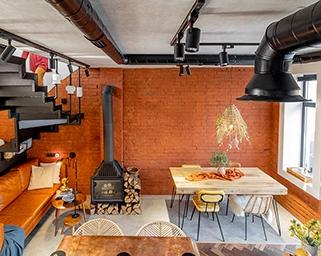How Does the Condition of Your HVAC Ductwork Affect Indoor Air Quality?
Damaged or leaking ductwork not only reduces efficiency and increases wear and tear – it can impact your home’s air quality. Learn the steps you can take to fix it.

By Tom Moor
Is your furniture extra dusty, or is there a mildew smell wafting through your home? It could signal issues with your ductwork. When air ducts develop problems like leaks, mold, or dust buildup, they do more than reduce efficiency – they affect your indoor air quality (IAQ).
Read on to discover how your ductwork can impact your air quality and how solutions like duct cleaning or sealing can make a big difference.
How ductwork impacts indoor air quality
If your HVAC system is the heart of your home’s climate control, your air ducts are like the arteries. Just like human arteries, if ducts become clogged or damaged, the whole system suffers. Air can’t flow efficiently, and what does get through may carry dust, allergens, or other unhealthy contaminants. This puts serious strain on your HVAC system and affects the quality of the air you and your family breathe every day.
Some of the common examples of how air ducts can worsen your home’s air quality include:
Mold growth inside ducts
Mold thrives in moist, dark places, making ductwork the perfect breeding ground, especially if there’s condensation or excess humidity present. Leaks or poorly insulated ducts can allow warm, moist air to mix with cooler surfaces, leading to condensation. Once mold in ductwork takes hold, spores can circulate through your home every time the system runs, which can worsen allergies, asthma, and other respiratory issues.
Leaky ducts bring in dust and contaminants
Leaky ductwork is extremely common; the average home loses about 20% of conditioned air through holes, leaks, and poorly installed ducts. HVAC ductwork that isn’t properly sealed can pull in dust, pollen, insulation fibers, and even fumes from areas like your attic, basement, or crawl space.
These leaks don’t just reduce system efficiency – they also mean you’re breathing in a cocktail of unfiltered contaminants. This can trigger allergies, reduce air quality, and make your home feel dustier overall.
Rodent and insect infestations
Does the thought of rodents hanging out in your ductwork give you shivers? Pests like mice, rats, squirrels, or insects that find their way into your ductwork through cracks or other small openings can cause significant air quality concerns. Droppings, nesting materials, and even decomposing remains can create foul odors and release harmful bacteria and allergens into your home.
Dirty ductwork
Sometimes, the problem is simply a buildup of dust, debris, pet hair, and even construction debris, especially after home renovations. While it’s completely normal to have some level of dust and debris present, in severe cases, these materials can clog your ducts, reduce airflow, and recirculate dirty air throughout your home. Over time, this makes your HVAC system work harder and causes poor indoor air quality.
How to improve your home’s air quality
If your ductwork is impacting your air quality, it’s important to act fast and contact an American Standard® dealer before a relatively small issue balloons into a big, expensive problem. Their solutions might include:
Duct cleaning
Duct cleaning doesn’t need to be performed regularly like HVAC maintenance, according to the U.S. Environmental Protection Agency. Instead, air duct cleaning can be a viable solution in specific cases of substantial visible mold growth, pest infestations, excessive debris, and after renovation projects that introduce contaminants such as drywall dust, paint particles, and insulation fibers into the home.
During professional duct cleaning, a technician uses specialized tools to remove built-up dust, debris, and contaminants from your ductwork and HVAC components. They’ll inspect the entire system, clean registers and grilles, and may use a high-powered vacuum to ensure everything is thoroughly cleared. This helps improve airflow, reduce allergens, and support better indoor air quality.
Duct sealing
Ducts can develop leaks, holes, and loose connections which can allow dust and other contaminants to enter and compromise your home’s air quality. Duct sealing is a relatively simple and budget-friendly way to close those leaks. A qualified HVAC technician can locate leaks and seal them using specialized materials like mastic sealant or metal tape.
Duct replacement
If you have insulated ducts and the insulation gets wet and moldy, replacement is often the safest option, according to the EPA, since mold can soak into the porous inner lining, and it is nearly impossible to completely clean.
Aside from mold damage, it might be time to replace your ducts if they’re over 15-20 years old, have significant leaks, or are seriously damaged. Visible rust, crushed sections, or persistent airflow issues are also signs it may be time for an upgrade.
How to keep your ductwork healthy
Some tips to keep your ducts clean and healthy include:
- Schedule regular duct inspections: Have a pro check your HVAC ductwork every couple of years for cracks, leaks, or signs of mold so small problems don’t turn into big ones.
- Change your air filters often: Dirty filters let dust and allergens build up in your system including your ducts. Changing them every 1-3 months keeps your air cleaner and your HVAC running smoothly. Learn more HVAC air filter replacement.
- Keep an eye out for moisture: If you notice damp spots, condensation, or musty smells near vents, it could mean there’s a moisture issue which can lead to mold inside your ducts. Installing a whole-home dehumidifier can lower humidity levels and prevent moisture problems.
- Improve your home’s ventilation: Using exhaust fans in bathrooms and kitchens, or adding fresh air intakes, can help reduce humidity and keep mold from growing in and around your ducts.
Contact an American Standard® dealer for a ductwork inspection
Poor indoor air quality can negatively affect the health of everyone in your home, especially those who suffer from allergies and asthma. If your ductwork is compromised and needs to be cleaned, sealed, or replaced, contact an American Standard dealer. Equipped with expert knowledge about ductwork and specialized tools, they can perform the necessary service to return your air ducts to proper condition again.
Author: Tom Moor
Expert review by Sean Goddard, Product Manager, Coils & Indoor Air Quality
Related articles



